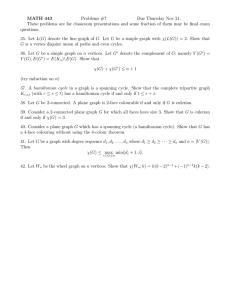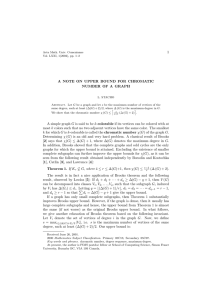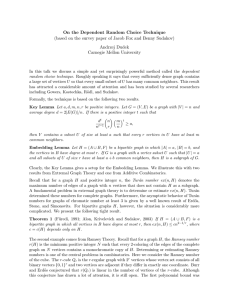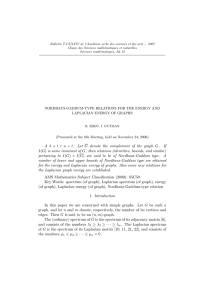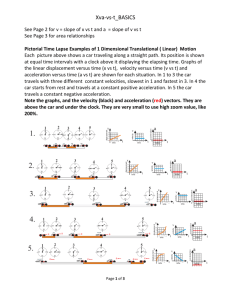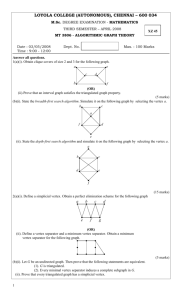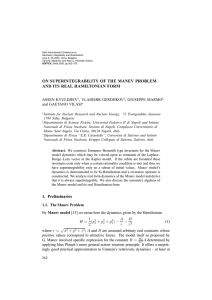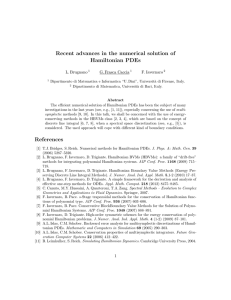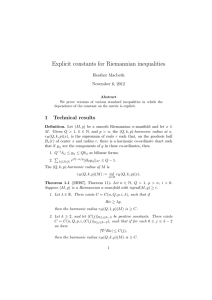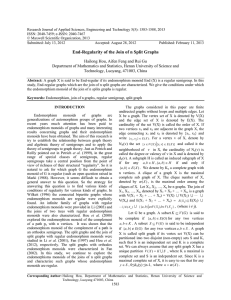Document 10677558
advertisement
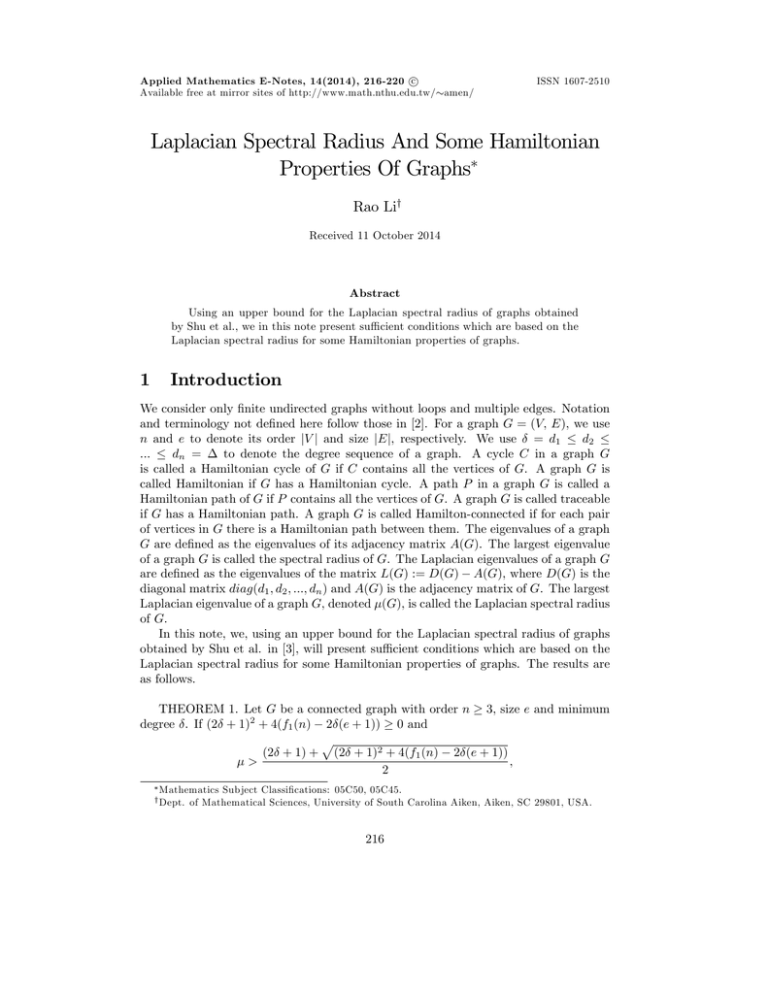
Applied Mathematics E-Notes, 14(2014), 216-220 c Available free at mirror sites of http://www.math.nthu.edu.tw/ amen/ ISSN 1607-2510 Laplacian Spectral Radius And Some Hamiltonian Properties Of Graphs Rao Liy Received 11 October 2014 Abstract Using an upper bound for the Laplacian spectral radius of graphs obtained by Shu et al., we in this note present su¢ cient conditions which are based on the Laplacian spectral radius for some Hamiltonian properties of graphs. 1 Introduction We consider only …nite undirected graphs without loops and multiple edges. Notation and terminology not de…ned here follow those in [2]. For a graph G = (V; E), we use n and e to denote its order jV j and size jEj, respectively. We use = d1 d2 ::: dn = to denote the degree sequence of a graph. A cycle C in a graph G is called a Hamiltonian cycle of G if C contains all the vertices of G. A graph G is called Hamiltonian if G has a Hamiltonian cycle. A path P in a graph G is called a Hamiltonian path of G if P contains all the vertices of G. A graph G is called traceable if G has a Hamiltonian path. A graph G is called Hamilton-connected if for each pair of vertices in G there is a Hamiltonian path between them. The eigenvalues of a graph G are de…ned as the eigenvalues of its adjacency matrix A(G). The largest eigenvalue of a graph G is called the spectral radius of G. The Laplacian eigenvalues of a graph G are de…ned as the eigenvalues of the matrix L(G) := D(G) A(G), where D(G) is the diagonal matrix diag(d1 ; d2 ; :::; dn ) and A(G) is the adjacency matrix of G. The largest Laplacian eigenvalue of a graph G, denoted (G), is called the Laplacian spectral radius of G. In this note, we, using an upper bound for the Laplacian spectral radius of graphs obtained by Shu et al. in [3], will present su¢ cient conditions which are based on the Laplacian spectral radius for some Hamiltonian properties of graphs. The results are as follows. THEOREM 1. Let G be a connected graph with order n 3, size e and minimum degree . If (2 + 1)2 + 4(f1 (n) 2 (e + 1)) 0 and p (2 + 1) + (2 + 1)2 + 4(f1 (n) 2 (e + 1)) > ; 2 Mathematics Subject Classi…cations: 05C50, 05C45. of Mathematical Sciences, University of South Carolina Aiken, Aiken, SC 29801, USA. y Dept. 216 R. Li 217 then G is Hamiltonian, where f1 (n) = 5(n 1)3 + 8(n 2)3 =8: THEOREM 2. Let G be a connected graph with order n 2, size e and minimum degree . If (2 + 1)2 + 4(f2 (n) 2 (e + 1)) 0 and p (2 + 1) + (2 + 1)2 + 4(f2 (n) 2 (e + 1)) ; > 2 then G is traceable, where f2 (n) = (n(n 2)2 + 8(n 3)3 + 4(n 2)(n 1)2 )=8: THEOREM 3. Let G be a connected graph with order n 3, size e and minimum degree . If (2 + 1)2 + 4(f3 (n) 2 (e + 1)) 0 and p (2 + 1) + (2 + 1)2 + 4(f3 (n) 2 (e + 1)) > ; 2 then G is Hamilton-connected, where f3 (n) = ((n 2)n2 + 8(n 3)3 + 4n(n 1)2 )=8. 2 Lemmas In order to prove the theorems above, we need the following results as our lemmas. LEMMA 1. Let G be a graph of order n 3 with degree sequence d1 dn . If n dk k < =) dn k n k; 2 then G is Hamiltonian. d2 LEMMA 2. Let G be a graph of order n 2 with degree sequence d1 dn . If n dk k 1 1 =) dn+1 k n k; 2 then G is traceable. d2 LEMMA 3. Let G be a graph of order n 3 with degree sequence d1 dn . If n ; dk 1 k =) dn k n k + 1; 2 k 2 then G is Hamilton-connected. d2 d1 LEMMA 4 ([3]). Let G be a connected graph of order n with degree sequence d2 dn . Then v u n 2 X 1 u 1 (G) d1 + + t d1 + di (di d1 ); 2 2 i=1 the equality holds if and only if G is a regular bipartite graph. Notice that Lemmas 1, 2, and 3 above are respectively Corollary 3 on Page 209, Corollary 6 on Page 210, and Theorem 12 on Page 218 in [1]. Next, we will present the proofs of Theorems 1–3. 218 3 Laplacian Spectral Radius and Hamiltonian Properties of Graphs Proofs In this section, we prove Theorems 1–3. PROOF of THEOREM 1. Let G be a graph satisfying the conditions in Theorem 1. Suppose that G is not Hamiltonian. Then, from Lemma 1, there exists an integer k and dn k n k 1. Obviously, k 1 and dk 1. Then, k < n2 such that dk from Lemma 4, we have that v u n 2 X 1 u 1 d1 + + t d1 + di (di d1 ); 2 2 i=1 Thus 2 (2 + 1) + 2 (1 + e) n X d2i : i=1 Notice that n X d2i k 3 + (n 1)2 + k(n 2k)(n k + (n 2)3 + 1)2 i=1 n 1 2 3 Set f1 (n) := 5(n 1)3 (n 2 1)3 + 8(n 8 = 1)3 + 8(n 8 5(n 2)3 2)3 : : Hence 2 2 (2 + 1) + 2 (1 + e) f1 (n) 0: Since (2 + 1) + 4(f1 (n) 2 (e + 1)) 0, we can solve the inequality and get p (2 + 1) + (2 + 1)2 + 4(f1 (n) 2 (e + 1)) ; 2 which is a contradiction. This completes the proof of Theorem 1. PROOF of THEOREM 2. Let G be a graph satisfying the conditions in Theorem 2. Suppose that G is not traceable. Then, from Lemma 2, there exists an integer k n2 such that dk k 1 and dn+1 k n k 1. Obviously, k 2 and dk 1. Then, from Lemma 4, we have that v u n 2 X 1 u 1 d1 + + t d1 + di (di d1 ); 2 2 i=1 Thus 2 (2 + 1) + 2 (1 + e) n X i=1 d2i : R. Li 219 Notice that n X d2i 1)2 + (n k(k 2k + 1)(n 1)2 + (k k 1)(n 1)2 i=1 2 = (n 2)(n 1)2 n n 2 + (n 3)3 + 2 2 2 n(n 2)2 + 8(n 3)3 + 4(n 2)(n 1)2 : 8 Set f2 (n) := 2)2 + 8(n n(n 3)3 + 4(n 8 2)(n 1)2 : Hence 2 (2 + 1) + 2 (1 + e) f2 (n) 0: Since (2 + 1)2 + 4(f2 (n) 2 (e + 1)) 0, we can solve the inequality and get p (2 + 1) + (2 + 1)2 + 4(f2 (n) 2 (e + 1)) ; 2 which is a contradiction. This completes the proof of Theorem 2. PROOF of THEOREM 3. Let G be a graph satisfying the conditions in Theorem 3. Suppose that G is not Hamilton-connected. Then, from Lemma 3, there exists an integer k such that 2 k n2 , dk 1 k, and dn k n k 1. Obviously, dk 1 1. Then, from Lemma 4, we have that v u n 2 X 1 u 1 d1 + + t d1 + di (di d1 ); 2 2 i=1 Thus 2 (2 + 1) + 2 (1 + e) n X d2i : i=1 Notice that n X d2i (k 1)k 2 + (n 2k + 1)(n k 1)2 + k(n i=1 n 2 n(n 1)2 + (n 3)3 + 2 2 2 2 3 (n 2)n + 8(n 3) + 4n(n 1)2 : 8 n = 2 Set f3 (n) := (n 2)n2 + 8(n 3)3 + 4n(n 8 1)2 : 1)2 220 Laplacian Spectral Radius and Hamiltonian Properties of Graphs Hence 2 2 (2 + 1) + 2 (1 + e) f3 (n) 0: Since (2 + 1) + 4(f3 (n) 2 (e + 1)) 0, we can solve the inequality and get p (2 + 1) + (2 + 1)2 + 4(f3 (n) 2 (e + 1)) ; 2 which is a contradiction. This completes the proof of Theorem 3. Acknowledgment. The author would like to thank the referee for his or her suggestions and comments which improve the …rst version of this paper. References [1] C. Berge, Graphs and hypergraphs. Translated from the French by Edward Minieka. Second revised edition. North-Holland Mathematical Library, Vol. 6. North-Holland Publishing Co., Amsterdam-London; American Elsevier Publishing Co., Inc., New York, 1976. [2] J. A. Bondy and U. S. R. Murty, Graph theory with applications. American Elsevier Publishing Co., Inc., New York, 1976. [3] J. Shu, Y. Hong, and W. Kai, A sharp upper bound on the largest eigenvalue of the Laplacian matrix of a graph, Linear Algebra Appl., 347(2002), 123–129.
